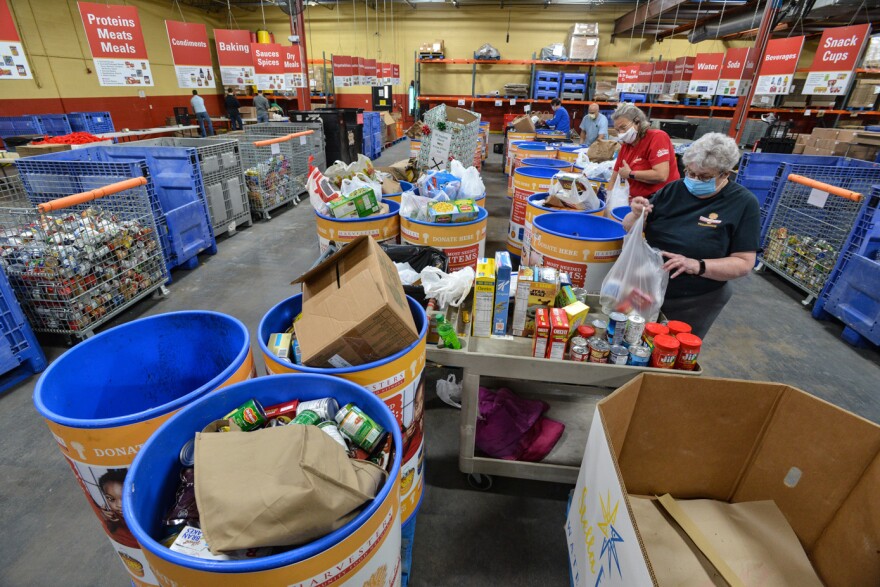A year into the pandemic, Missouri food banks continue to experience unprecedented demand. Feeding Missouri distributes more than 120 million pounds of food every year through its network of six food banks. KCUR’s Elle Moxley spoke with state director Scott Baker about the rising cost of food and what hunger nonprofits need right now.
ELLE MOXLEY, reporter: The last time we spoke, it was early on in the pandemic. We were still seeing supply chain issues, things like tuna and toilet paper and peanut butter were hard to come by. What's the latest? What do our food bank shelves look like right now?
SCOTT BAKER, Feeding Missouri: Supply continues to be a challenge. Not for the same reasons necessarily as before. Before it was a transportation issue. It was a just general overall availability issue. Now it's really a cost issue. I just recently compiled some data, and the Missouri food banks in the month of January — comparing January 2021 to January 2020, right before the pandemic — spent over 300% more on food purchase than they did in the previous year. I have one food bank that just on shelf-stable product alone spent 16 times more month over month than before.
EM: Is this kind of a two-pronged problem? Are we both seeing an increase in food costs as well as an increase in demand right now?
SB: Yeah, it really is. You know, we're entering an interesting time here in this pandemic response in that we're starting to see the light at the end of the tunnel. We're starting to see the vaccinations and things of that nature, but not to sound like a Debbie Downer, you're still in the tunnel when you see that light. So we're still there. People are understandably optimistic, so we're starting to see them move on, if you will. People were very, very generous during the heart of 2020. Now people are starting to move on a little bit and probably don't realize that there are still a lot of people who are hurting, a lot of people who are seeking assistance.

EM: Folks that are out of work right now, or folks that have tried looking for work and maybe are no longer even classified as unemployed. They've had to leave the workforce for a variety of reasons, whether that's safety or child care, their kid's school not being on a normal schedule right now. What are you kind of hearing from food banks about what some of the problems are?
SB: One of our biggest challenges as people see any kind of positive news about employment rates is they think, ‘Well then, everybody's fine.’ But we really are seeing situations of people who are underemployed compared to where they were before the pandemic, meaning they may be employed, but they're making a lot less money.
As you referenced, there are parents who are having to stay home still some with their kids. That's starting to get better across Missouri, but there are lots of different reasons, and costs continue to go up for other things. And as we talked about before, when a family is faced with financial trouble, they're looking at utilities, they're looking at housing and medical expenses. One of the things, unfortunately, that can go, if you will, or at least people have some flexibility to cut back more than they should is on nutrition.
And that's what we're seeing right now is even as people do (go back to work). You hear the term gig workers or people who maybe even worked in restaurants or things of that nature who were so impacted by the pandemic. They are starting to go back to work, and they're starting to see some income, but it's not nearly at the level that it was before the pandemic. Making ends meet is still a very, very big challenge for a lot of people.
EM: When we talk about hunger, and we talk about hungry kids, in particular, schools have always been a huge part of that equation. It's the place where in a lot of families kids get two of their meals per day. And early in the pandemic, we were really worried about how kids were going to go without. Has having those school meal programs running throughout the pandemic helped alleviate any of the burden on food banks?
SB: You know, the absence of the school meals was a real problem, but as you mentioned, it's, best case, usually two meals a day. You still have the evenings, you still have the weekends. We're still seeing a little bit, especially in high school, students are still only in class two days out of the week. You're right. There's a heavy reliance on school meals in a lot of households. And that sort of inconsistency of availability has had a big impact.




